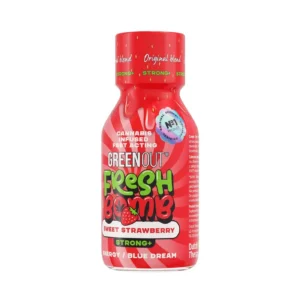It's no secret that hemp has a wide variety of uses. All thanks to hemp's ability to produce a wide range of chemicals. More than 500 of them have been identified in the plant, some of which are also common in other plants, such as terpenes and flavonoids responsible for the taste and smell of hemp. However, 144 of the chemicals in hemp are cannabinoids.
How do cannabinoids work?
You've probably heard of tetrahydrocannabinol (THC), which, in addition to its high medicinal value, also produces intoxicating effects. It's a substance that is illegal in Poland, but it's just one of many cannabinoids. Cannabidiol (CBD), on the other hand, also has medicinal properties and health-promoting effects, but does not contain psychoactive substances. These are just two of the hundreds of cannabinoids found in hemp. To understand how cannabis works, you must first understand how cannabinoids interact with your body.
The endocannabinoid system
In the 1990s, cannabinoid researchers discovered the endocannabinoid system (ECS) in the human body. The endocannabinoid system consists of:
- cannabinoid receptors
- endocannabinoids
- metabolic enzymes
One of the most important components of the ECS is receptors. The main receptors spread throughout the human body are CB1 and CB2 receptors. A plant cannabinoid is known to interact with each of these two receptors.
How does the endocannabinoid system work?
The human body is unable to produce THC on its own. So scientists tried to discover why these receptors appeared in humans at all. Studies have shown that they can be found in all vertebrates and interact with naturally produced chemicals in the body - endocannabinoids. These substances are produced in response to external factors such as pain, low or high temperatures. The interaction between endocannabinoids and their corresponding receptors plays a key role in maintaining the body's internal balance and homeostasis. The endocannabinoid system is responsible for regulating very important aspects of your health, such as:
- appetite
- blood pressure
- body temperature
- energy
- pulse
- immune response
- memory
- mood
- sleep
- muscle control
- desire
- pain response
Endocannabinoid deficiencies
So as you can imagine, keeping the ECS in good shape is extremely important, not only for our physical health, but also for our mental health. Researchers suggest that cannabinoid deficiencies may be partly responsible for a number of conditions, especially those in the process of treatments respond well to cannabis. A poorly functioning endocannabinoid system can lead to depression, arthritis, fibromyalgia, or Crohn's disease. Cannabinoids found in cannabis are almost twinned with endocannabinoids produced by our body. To distinguish them, they are called phytocannabinoids. When phytocannabinoids enter the human body, they begin to mimic endocannabinoids and interact with CB1 and CB2 receptors or other parts of the ECS.
Cannabinoid interactions
There are more than 140 known types of cannabinoids, and they all vary to a greater or lesser extent. Some of them occur naturally in the plant, while others are found, for example, in burnt hemp resin. The way they are produced often involves a chain of chemical transformations between cannabinoids. This means that some cannabinoids are transformed by the plant itself or human intervention into others. This is how THC is produced, for example: in the cannabis plant it starts out as CBGA, the plant transforms into THCA, and then a human heats the substance while smoking, turning it into THC.
If you notice cannabinoids with similar names, it means that they are most likely part of the same chain of transformations. The changes in chemical structure may be minor, but they can significantly affect a substance's therapeutic effects. As cannabinoids transform from one form to another, their level or type of psychoactivity and specific therapeutic effects can change. Different cannabinoids activate the endocannabinoid system in different ways.
Dawn effect
To make things a little more complicated, it should be mentioned that the effects of cannabinoids can be influenced by other cannabinoids, but also by terpenes and flavonoids present in the cannabis consumed. This therapeutic synergy is known as the "entourage effect," and is confirmation that the active chemicals found in cannabis work together to create an effect that could not be produced by just one of them.
The effects of the dawn effect are best illustrated with THC and CBD. Growers have long known about the ability of CBD to influence high hemp production, but only recently have scientists been able to measure specific effects. Most studies suggest that the simultaneous consumption of THC and CBD can help reduce or completely eliminate the side effects caused by taking THC, such as memory disorders or feelings of anxiety.
If the theory is true, and available sources and the state of research indicate that it is, we are dealing with an endless source of possibilities. Given the number of different cannabinoids produced by specific strains of cannabis, the number of potential combinations is impossible to estimate. Each cannabis strain is a unique blend of active substances that can exhibit surprising effects on the human body. The entourage effect is still under research, but currently available studies can help you decide which blend of cannabinoids will work best for you.
Cannabinoid acids
When a cannabis plant produces cannabinoids, it actually produces their "acidic form." For example, the THC in cannabis is produced as THCA and only transforms into THC once - when a person heats the substance for consumption. It is interesting to note that cannabinoid acids, despite being considered inactive, actually offer great therapeutic potential. The acids are absorbed by the body, but do not appear to enter the brain, which is probably why they were originally prescribed as therapeutic cannabinoids. All the cannabinoids produced in the hemp plant are cannabinoid acids - they are derived from the cannabinoid CBGA. There are very few "activated" substances in cannabis flowers, as in the case of THCA, which gets decarboxylated after smoking.
Types of cannabinoids
Currently, we know that there are about 144 different cannabinoids in cannabis, at the same time we can assume that we still haven't discovered all of them yet. Although each exhibits slightly different properties and forms different combinations, it is worth mentioning that there are a few cannabinoids that are particularly widespread:
THC
CBD
THCV
CBG
CBN
CBC








